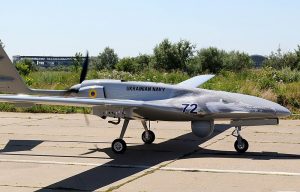As the Russia-Ukraine war rages on, the world is bracing itself for a new wave of accelerated defense spending. However, this type of conflict can impact more than military budgets; it could also catalyze changes in procurement priorities. For example, the successful deployment of new Russian electronic warfare equipment in Ukraine in 2014, and later in Syria, fueled research and development into and adoption of communications solutions that function (perhaps not perfectly) in GPS-denied environments. The Russia-Ukraine war too will bring about changes in the defense procurement balance, and defense leaders must be ready for the change.
Ukraine’s successful fielding of the Turkish Bayraktar TB2 unmanned combat aerial vehicle (UCAV) against Russian forces could frustrate Western market incumbents. This UCAV, which saw action in Libya and Syria, has yet again proven its ability to engage Russian platforms. The TB2’s tactical success and the media frenzy that followed is advantageous to Baykar, the TB2’s manufacturer, because several nations are currently prospecting for the acquisition of new UCAV fleets.
The traditional preferred UCAV solution for several nations was the United States’ General Atomics MQ-9 Reaper or its derivatives. The UAE and Taiwan have been trying to acquire several MQ-9 units, but buying such advanced equipment takes time and is sometimes cumbersome. The Department of State approval that is mandatory for a U.S. Foreign Military Sale (FMS) can be prone to the political concerns of the time, and the security protocols imposed by the United States on foreign operators of these UCAVs are complex and operationally constraining.
The Turkish suite of unmanned aerial vehicles on offer also includes the Medium Altitude Long Endurance (MALE) Turkish Aerospace Industries Anka and High Altitude Long Endurance (HALE) Baykar Akinci, giving customers the option to select diverse UAV/UCAV mixes to match their operational requirements (However, note that only the TB2 has been extensively combat-proven; the other Turkish UAV solutions are yet to meet their baptism by fire.) Compared to the U.S. alternatives, these solutions are cheaper and can be procured rapidly off-the-shelf with no government-imposed constraints on the end user. Turkish defense manufacturers also offer domestic co-production options, which are attractive to countries keen to develop their indigenous industry. Thus, it is likely that the TB2’s performance in Ukraine would generate more orders of several classes of Turkish UAVs/UCAVs, cutting into the market share of U.S. suppliers, perhaps even in traditional U.S. defense sales strongholds.
Other segments that are likely to be in high demand are advanced active protection systems (APS) and advanced camouflage solutions. Ukrainian troops have seriously challenged the Russian armored onslaught, destroying several tanks and armored vehicles with Javelins and Next Generation Light Armored Weapons (NLAW). Several of these tanks were equipped with older APS, which were not able to counter modern guided missile systems. Similarly, older Russian tanks that were deployed in Ukraine weren’t equipped with advanced signature reduction solutions. These camouflage solutions would have made it harder for guided weapons to lock on and destroy armored vehicles. As a result of this experience, the next wave of Main Battle Tank/ Infantry Fighting Vehicle modernizations in several countries may include APS and camouflage upgrades as a priority, which could bode well for companies like Rafael and Saab that offer capable APS/camouflage solutions.
The procurement modus operandi in Europe is also anticipated to change because of the conflict. Countries like Germany, which have traditionally favored time-consuming joint military procurement programs, may be more open to accelerated off-the-shelf purchases to improve their dangerously low operational readiness. Germany may have to look at non-traditional military suppliers and diversify its equipment portfolio. The Israeli defense industry could potentially benefit and could be a favored supplier, as Israel already leases UAVs to Germany. Another characteristic change can be expected from the Nordic region. Norway and Sweden, which had reduced collaboration on joint procurements, could come together again and embark on collective procurements to improve interoperability of defense equipment against their common foe, Russia. Suppliers that offer solutions that are interoperable and are more suitable for “collective defense” could be well placed to win contracts.
Conflicts often cause permanent changes in the demand-supply equation for military hardware and related solutions, as lessons learnt – be they political, economic, or technological – are evaluated. The Russia-Ukraine conflict is having this effect as new experiences that impact procurement emerge. These include the marketability and potential of Turkish UCAVs, the need for more smart military equipment like APS and signature reduction systems, the emergence of off-the-shelf procurements, and finally, the need for “collective defense” oriented military equipment. The new procurement equation seems to favor nontraditional suppliers and further diversification of the procurement base.

































